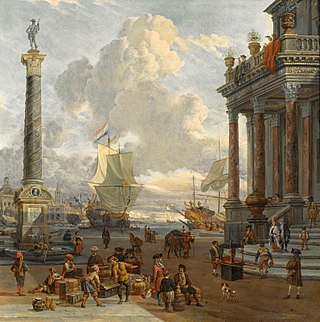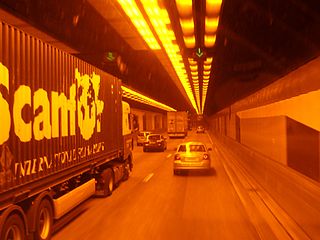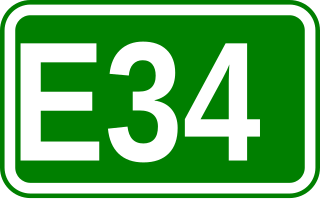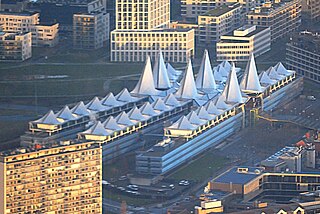
Transport in Belgium is facilitated with well-developed road, air, rail and water networks. The rail network has 2,950 km (1,830 mi) of electrified tracks. There are 118,414 km (73,579 mi) of roads, among which there are 1,747 km (1,086 mi) of motorways, 13,892 km (8,632 mi) of main roads and 102,775 km (63,861 mi) of other paved roads. There is also a well-developed urban rail network in Brussels, Antwerp, Ghent and Charleroi. The ports of Antwerp and Bruges-Zeebrugge are two of the biggest seaports in Europe. Brussels Airport is Belgium's biggest airport.

Antwerp Province, between 1815 and 1830 known as Central Brabant, is the northernmost province both of the Flemish Region, also called Flanders, and of Belgium. It borders on the North Brabant province of the Netherlands to the north and the Belgian provinces of Limburg, Flemish Brabant and East Flanders. Its capital is Antwerp, which includes the Port of Antwerp, the second-largest seaport in Europe. It has an area of 2,876 km2 (1,110 sq mi), and with over 1.85 million inhabitants as of January 2019, is the country's most populous province. The province consists of three arrondissements: Antwerp, Mechelen and Turnhout. The eastern part of the province comprises the main part of the Campine region.
The Delta Works is a series of construction projects in the southwest of the Netherlands to protect a large area of land around the Rhine–Meuse–Scheldt delta from the sea. Constructed between 1954 and 1997, the works consist of dams, sluices, locks, dykes, levees, and storm surge barriers located in the provinces of South Holland and Zeeland.

The Scheldt is a 435-kilometre-long (270 mi) river that flows through northern France, western Belgium, and the southwestern part of the Netherlands, with its mouth at the North Sea. Its name is derived from an adjective corresponding to Old English sċeald ("shallow"), Modern English shoal, Low German schol, West Frisian skol, and obsolete Swedish skäll ("thin").

The Western Scheldt in the province of Zeeland in the southwestern Netherlands, is the estuary of the Scheldt river. This river once had several estuaries, but the others are now disconnected from the Scheldt, leaving the Westerschelde as its only direct route to the sea. The Western Scheldt is an important shipping route to the Port of Antwerp, Belgium. Unlike the Eastern Scheldt estuary, it could not be closed off from the sea by a dam as part of the Delta Works. Instead, the dykes around it have been heightened and reinforced.

Zwijndrecht is both a village and a municipality located in the Flemish province of Antwerp, in Belgium. As well as Zwijndrecht proper, the municipality includes the village of Burcht. In 2021, Zwijndrecht had a total population of 19,263.

The National Redoubt was a strategic defensive belt of fortifications built in Belgium. The National redoubt was the infrastructural cornerstone of Belgian defensive strategy from 1890–1940.
The Western Freeway was a proposed controlled-access highway in Mumbai, India that would stretch from Marine Drive in South Mumbai to Kandivli in the north, a distance of 29 km. The project envisioned the construction of four major sea links over the Arabian Sea along Mumbai's western coastline to reduce traffic-congestion between the Western Suburbs and South Mumbai.

Government procurement or public procurement is when a governing body purchases goods, works, and services from an organization for themselves or the taxpayers. In 2019, public procurement accounted for approximately 12% of GDP in OECD countries. In 2021 the World Bank Group estimated that public procurement made up about 15% of global GDP. Therefore, government procurement accounts for a substantial part of the global economy.
The Oosterweel Link is a construction project first proposed in 1996, intended to complete the R1 Antwerp Ring Road in Antwerp, Belgium. The firm Antwerp Mobility Management Company, is the Flemish Government controlled organisation assigned responsibility for the project. The Oosterweel link will connect the Expressweg (E34) near Blokkersdijk via a toll tunnel underneath the Scheldt, leading to a dual-layered tunnel under the Albert Canal and connecting with the Antwerp Ring Road at Merksem and Deurne.

The Kennedytunnel is an important road, rail, and bicycle tunnel to the south of Antwerp, Belgium, under the Scheldt river. The road tunnel forms a part of Highway R1 – the not yet completed inner ring motorway surrounding the city. Opened to road traffic on 31 May 1969, and to rail traffic on 1 February 1970, the tunnel was named after John F. Kennedy, the thirty-fifth President of the United States.

European route E34 forms part of the United Nations International E-road network. It connects Zeebrugge, the major seaport of Bruges, with Bad Oeynhausen, a German spa town located beside the River Weser at the eastern edge of North Rhine-Westphalia. At Bad Oeynhausen the E34 links to the E30, a major pan European east-west artery. It also passes, relatively briefly, through the Netherlands, following the southern by-pass of Eindhoven. Within Germany the route follows from south-west to north-east the full length of North Rhine-Westphalia.
Water supply and sanitation in Belgium is provided by a large variety of organizations: Most of the 581 municipalities of Belgium have delegated the responsibility for water supply and sanitation to regional or inter-municipal utilities. There are more than 62 water supply utilities, including 2 regional, 30 inter-municipal and 30 municipal utilities. Another 100 mostly small municipalities provide services directly without having a legally of financially separate entity for water supply. Water is not scarce in Belgium and water supply is generally continuous and of good quality. However, wastewater treatment has long lagged behind and Brussels only achieved full treatment of its wastewater in 2007. In 2004 the European Court of Justice ruled condemning Belgium's failure to comply with the EU wastewater directive, and the ruling has not been fully complied with so far. Wallonia satisfies 55% of the national needs in drinking water while it counts only 37% of the population. Flanders and Brussels are dependent on drinking water from Wallonia, at a level of 40% and 98% respectively.

The A1, also commonly Rruga e Kombit or SH10, is the longest and only toll motorway in Albania, stretching 114 kilometres (71 mi) in the counties of Lezhë and Kukës. It consists for the most part of two traffic lanes and an emergency lane in each driving direction separated by a central reservation.

The A12 is an incomplete motorway in Belgium. The road starts at the Dutch border near Zandvliet and goes to Antwerp. There the A12 goes onto the Antwerp ring road R1. Then the road goes via Wilrijk in the direction of Brussels. From here on, it has frontage roads on both sides. Between Wilrijk and Schelle, the A12 is an expressway with major at-grade intersections that contain also the frontage roads. There, from Schelle, it is again a motorway. Then, in Boom, a tunnel leads the A12 under the Rupel river, where the frontage roads take a bridge and then fuse with the motorway itself. Between Breendonk and Sint-Brixius-Rode, there are again at-grade intersections, and then it is again a motorway, until Brussels, where it ends onto the Brussels Ring.

Antwerp is a city and a municipality in the Flemish Region of Belgium. It is the capital and largest city of Antwerp Province, and the third largest city in Belgium by area at 204.51 km2 (78.96 sq mi) after Tournai and Couvin. With a population of 536,079, it is the most populous municipality in Belgium, and with a metropolitan population of over 1,200,000 people, the country's second-largest metropolitan region after Brussels.
Ringland is a non-governmental organization in Antwerp, Belgium, that is demanding that the authorities install a roof covering over the entire ring road around Antwerp.

Antwerpen-Noord junction is a highway junction in the northern part of the Antwerp agglomeration, located in the district of Ekeren. The junction lies at the northern end of the R1 ring road around the city of Antwerp, where the R1 connects to the A1/E19 road towards Breda, and the A12 road towards the port of Antwerp and, further to the north, also to the city of Bergen op Zoom.

The Palace of Justice of Antwerp commonly known as the Antwerp Law Courts, De Frietzakken, and the Butterfly Palace, is a law court building located in the Belgium city of Antwerp on the site of the former Antwerp-South railway station. The building was built over the Bolivar Tunnel and it houses eight district civil and criminal courts. It was inaugurated on 28 March 2006 by King Albert, Minister of Justice Laurette Onkelinx, Minister of Finance Didier Reynders, governor Camille Paulus and mayor Patrick Janssens. The building was designed by the Richard Rogers Partnership, VK Studio and Arup.
















